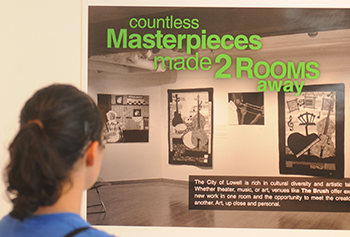Students Gain Real-World Experience Designing Ad Campaign for City

04/16/2013
By Sheila Eppolito
Lowell City Manager Bernie Lynch ‘78 was very impressed.
While marketing consultants and professional experts had proposed dozens of campaigns about his city over the years, most didn’t click.
Four teams of students in Assoc. Prof. Karen Roehr’s Advertising Design class competed against one another—just like real-world ad agencies—for the City of Lowell advertising account. The project—funded by a Creative Economy grant won by Roehr—challenged students to create campaigns for the city. The winning team of Jason Taylor ’13, Juliana de Souza ’12 and Mike Noonan ’12 used a variety of media including bus wraps, magazine and newspaper ads and mall banners to convey their version of Lowell.
The dramatic, urban-feeling black and white campaign—dubbed Lowell by the Numbers—showcases Lowell’s recreational, cultural and entertainment offerings through images shot by Lecturer Chehalis Hegner’s photography students including de Souza. Concise copy— penned by Taylor—follows a theme of wide variety in close proximity: one headline for the Tsongas Center at UMass Lowell says “Thirty Decibels Louder: 20 feet closer” while another touts the city’s vibrant arts community with the headline “Countless Masterpieces Made 2 Rooms Away.”
At a ceremony unveiling the winning campaign, Lynch was effusive.
“This campaign gets the city. We’re not Boston, we’re Lowell. We’re not like anywhere else, and that’s what makes us who we are. This student campaign nailed it.”
Different Students, Different Skills
Like many real-world businesses, advertising relies on people from a variety of backgrounds.
“While Jason and I banged out possible concepts for the campaign and began designing them, Mike was behind the scenes pulling the numbers together and reaching out to professionals in the community,” says de Souza.
For Noonan, the project offered a real-life foray into the business of advertising—and tapped into a creative side he always knew he had.
“Professor Roehr’s project was the favorite of my college career—it wasn’t just classroom theory—we gathered statistics on the best places to advertise, analyzed the costs associated with the campaign, and met face-to-face with executives from Simon Mall to discuss using their venues for our ads,” he says. While Noonan is grateful to have landed a financial position with Fidelity Investments, he doesn’t rule out working in advertising some day.
“I always think of that advertising class—if I were able to do something like that for work I would be grateful,” he says.
For Taylor, creating an ad that hangs nine by five feet in the Burlington Mall was surreal.
“My parents went to the mall and took pictures of the ads—people were looking at them like they were tourists,” he says.
According to Roehr, the project gave students valuable experience with professional collaboration, compromise and creativity. Their tangible results encourage people to take action by visiting Lowell, helping to raise public awareness and promote business, increase attendance at the Tsongas Center, museums, theaters, music festivals and art exhibits.
In addition to the Burlington Mall, the ads can be seen on buses in Somerville, Burlington and Cambridge, outside the Alewife T station, and in WGBH Magazine’s May issue.
